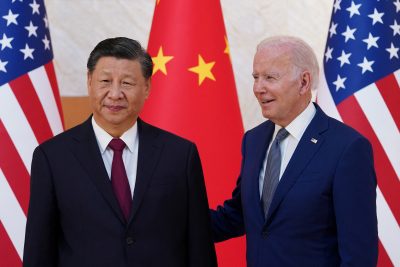China
Great power competition has shifted in the United States’ favour

Author: Ryan Hass, Brookings Institution
At the start of 2022, China’s economy appeared strong, Beijing seemed to have contained the spread of COVID-19, Sino–Russian relations were deepening and there was growing talk of autocracies stealing the march on democracies across the world. China’s leaders were proclaiming that ‘time and momentum’ were on China’s side in its great power competition with the United States.
Meanwhile, the United States was mired in partisan paralysis, with President Joe Biden’s ‘Build Back Better’ agenda seemingly stuck. Washington was reeling from the reputational damage of the United States’ chaotic withdrawal from Afghanistan. Within Asia, talk was growing louder of China dominating the 21st century.
A year later, the script reads differently. China’s economy has turned sluggish, pulled down by expanding state intervention in the economy, waves of COVID-related lockdowns, a property sector slowdown and softening international demand for Chinese exports. Beijing’s messy exit from its zero-COVID policy has exacerbated domestic stressors. Even as China remains the largest trading partner for most of the world, its economic lustre has dimmed amid declining economic growth.
China’s international image in most of the developed world has also suffered. Part of this owes to China’s rhetorical support for Russia amid Moscow’s barbarism in Ukraine. China’s plummeting image is also attributable to its hardening authoritarianism at home, its nationalistic ‘wolf warrior’ diplomacy and its growing military activity along its periphery, including in the waters and airspace around Taiwan.
By comparison, Biden’s political position has strengthened. At home, the Biden administration secured passage of the bipartisan Infrastructure Investment and Jobs Act, the CHIPS and Science Act and the Inflation Reduction Act, which together add up to over US$1 trillion in government spending. Though elements of these investments favouring domestic manufacturing have generated friction with US trading partners, they represent a generational investment in US innovation. Technology companies such as Taiwan Semiconductor Manufacturing Company, Samsung, Micron, SK Hynix, Intel and IBM announced investments in semiconductor production in the United States exceeding US$100 billion.
The United States also strengthened its position abroad. Transatlantic unity deepened under the stress of the joint response to Russia’s invasion of Ukraine. Coordination strengthened in other purpose-driven groupings, such as the Quad and AUKUS. The G7 bolstered its relevance as its members acted with greater cohesion on global challenges, including financing Indonesia and Vietnam’s clean energy transitions. US–ASEAN ties were elevated to a comprehensive strategic partnership. The United States’ relationships with Pacific Island countries also advanced, including through the release of the White House’s Pacific Partnership Strategy.
Looking ahead, several potential flashpoints will require careful management in 2023, including North Korea’s nuclear program, China–India border flareups and rising tensions in the Taiwan Strait. A key question will be whether the United States’ progress and China’s relative setbacks over the past year create conditions conducive for Washington and Beijing to lower the temperature of bilateral relations.
Biden will face domestic political pressure to maintain an unyielding posture on China. China’s President Xi Jinping, similarly, is unlikely to relent on issues that are aggravating tensions. Still, from a strategic standpoint, the United States’ global partners would welcome efforts by Washington to cool tensions, even if they do not yield reciprocal actions from Beijing.
US officials are receiving consistent demands from foreign counterparts to responsibly manage competition with China. Many countries around the world are more focussed on addressing proximate challenges, such as rising sea levels and mounting debt, than they are on great power competition. They want to see the United States galvanise global efforts to tackle common challenges rather than grow fixated on tit-for-tat games with China.
The Biden administration entered office believing it needed to invest at home and deepen relations with partners to put the United States in a ‘situation of strength’ to deal directly with China. Now that it has made historic investments in US innovation and strengthened bonds with global partners, a key question is whether the Biden…
Business
China Dismantles Prominent Uyghur Business Landmark in Xinjiang – Shia Waves

The Chinese government demolished the Rebiya Kadeer Trade Center in Xinjiang, affecting Uyghur culture and commerce, prompting criticism from activists amid concerns over cultural erasure and human rights violations.
Demolition of a Cultural Landmark
The Chinese government recently demolished the Rebiya Kadeer Trade Center in Urumqi, Xinjiang, a vital hub for Uyghur culture and commerce, as reported by VOA. This center, once inhabited by more than 800 predominantly Uyghur-owned businesses, has been deserted since 2009. Authorities forcibly ordered local business owners to vacate the premises before proceeding with the demolition, which took place without any public notice.
Condemnation from Activists
Uyghur rights activists have condemned this demolition, perceiving it as part of China’s broader strategy to undermine Uyghur identity and heritage. The event has sparked heightened international concern regarding China’s policies in Xinjiang, which have been characterized by allegations of mass detentions and cultural suppression, prompting claims of crimes against humanity.
Rebiya Kadeer’s Response
Rebiya Kadeer, the center’s namesake and a notable Uyghur rights advocate, criticized the demolition as a deliberate attempt to erase her legacy. Kadeer, who has been living in exile in the U.S. since her release from imprisonment in 2005, continues to advocate for Uyghur rights. She has expressed that her family members have suffered persecution due to her activism, while the Chinese government has yet to comment on the legal ramifications of the demolition.
Source : China Demolishes Uyghur Business Landmark in Xinjiang – Shia Waves
China
China Expands Nationwide Private Pension Scheme After Two-Year Pilot Program

China’s private pension scheme, previously piloted in 36 cities, will roll out nationwide on December 15, 2024, enabling workers to open tax-deferred accounts. The initiative aims to enhance retirement savings, address aging population challenges, and stimulate financial sector growth.
After a two-year pilot program, China has officially expanded its private pension scheme nationwide. Starting December 15, 2024, workers covered by urban employee basic pension insurance or urban-rural resident basic pension insurance across the country can participate in this supplementary pension scheme. This nationwide rollout represents a significant milestone in China’s efforts to build a comprehensive pension system, addressing the challenges of a rapidly aging population.
On December 12, 2024, the Ministry of Human Resources and Social Security, together with four other departments including the Ministry of Finance, the State Taxation Administration, the Financial Regulatory Administration, and the China Securities Regulatory Commission, announced the nationwide implementation of China’s private pension scheme effective December 15, 2024. The initiative extends eligibility to all workers enrolled in urban employee basic pension insurance or urban-rural resident basic pension insurance.
A notable development is the expansion of tax incentives for private pensions, previously limited to pilot cities, to a national scale. Participants can now enjoy these benefits across China, with government agencies collaborating to ensure seamless implementation and to encourage broad participation through these enhanced incentives.
China first introduced its private pension scheme in November 2022 as a pilot program covering 36 cities and regions, including major hubs like Beijing, Shanghai, Guangzhou, Xi’an, and Chengdu. Under the program, individuals were allowed to open tax-deferred private pension accounts, contributing up to RMB 12,000 (approximately $1,654) annually to invest in a range of retirement products such as bank deposits, mutual funds, commercial pension insurance, and wealth management products.
Read more about China’s private pension pilot program launched two years ago: China Officially Launches New Private Pension Scheme – Who Can Take Part?
The nationwide implementation underscores the Chinese government’s commitment to addressing demographic challenges and promoting economic resilience. By providing tax advantages and expanding access, the scheme aims to incentivize long-term savings and foster greater participation in personal retirement planning.
The reform is expected to catalyze growth in China’s financial and insurance sectors while offering individuals a reliable mechanism to enhance their retirement security.
| This article was first published by China Briefing , which is produced by Dezan Shira & Associates. The firm assists foreign investors throughout Asia from offices across the world, including in in China, Hong Kong, Vietnam, Singapore, and India . Readers may write to info@dezshira.com for more support. |
Read the rest of the original article.
China
How a scandal over sanitary pads is shaping feminist activism in China

Chinese sanitary pad brands face scandal over misleading product quality and pH levels. Consumer outrage grows amid larger issues of women’s health neglect and activism for better standards linked to declining fertility rates.
A string of prominent sanitary pad brands in China have become embroiled in a scandal about the quality of their products. The controversy began in early November when consumers complained that that the advertised lengths of many sanitary pads were misleading.
Then, a few days later, customers discovered that many pads had pH levels similar to textiles such as curtains and tablecloths that do not come into frequent contact with skin, potentially causing irritation or harm to users.
The anger only intensified when ABC, one of the companies at the centre of the controversy, responded dismissively to concerned consumers. ABC emphasised that it was complying with national standards, and reportedly replied to a complaint with: “If you cannot accept it, then you can choose not to buy it”.
Chinese companies have since apologised for their sub-par products, and ABC has even said that it was “deeply sorry” for its “inappropriate” response. But for many women in China, this scandal is about more than just defective products. It is part of a troubling pattern in which women’s health and dignity is blatantly disregarded.
In 2022, Chinese women took to social media to advocate for sanitary pads to be sold on trains. Their demands were swiftly dismissed, with China Railway saying sanitary pads were “private items” that women should prepare for themselves in advance.
Some people on the internet echoed this sentiment, arguing that it was inappropriate and unhygienic to sell sanitary pads on trains. “You don’t want sanitary pads sold alongside food, do you?”, one wrote.
Remarks like this laid bare not only the stigma surrounding menstrual blood in China, where it is seen as polluting and shameful, but also the widespread ignorance among men about menstruation. This was again highlighted by one social media user who questioned absurdly: “Why can’t women just hold it in?” The recent scandal over poor quality sanitary pads is yet another chapter in this story.
The neglect of women’s basic needs in China has worsened with the government’s push for higher birth rates. China’s ruling Communist party began actively promoting higher birth rates in the mid-2010s after decades of limiting most families to one child. The push is driven primarily by the state’s concerns over an ageing population and a shrinking labour force.
This pro-natalist agenda, which has been bolstered by media campaigns urging women to prioritise marriage and motherhood, has pressured many to sacrifice their education and careers. In anticipation of having to provide paid maternity leave, employers also often discriminate in the processes of hiring and promotions.
Meanwhile, feminist advocacy faces censorship and suppression. This has included the shutdown of influential media platforms like Feminist Voices and the blocking of #MeToo-related hashtags. Activists have resorted to creative methods, such as using symbols like the “Rice Bunny” (a term that is pronounced “mi tu” in Chinese) emoji, to navigate strict surveillance and content filtering that targets discussions on gender equality.
Why the #RiceBunny hashtag has become China’s #MeToo.
Fighting for change
Women in China are now rallying for higher standards in the production and regulation of sanitary products. They are actively submitting comments via the government’s online platform for the public to provide feedback to standard setting officials.
On November 22, a representative from the organisation responsible for drafting the new standards stated that public feedback had been heard and will be considered in the process. However, this response is far from satisfactory. The same companies that produce sanitary pads in China are heavily involved in setting these standards.
Women’s active involvement in shaping the revision of national standards is reflective of a consistent strategy in which they use government-provided channels for political participation. Yet women in China have now also started to link the issue of low-quality sanitary products to broader societal challenges, including falling fertility rates.
In the 1970s, when China first implemented its one-child policy, over six children were born for every woman of childbearing age. This had dropped to an average of one-and-a-half by the 2000s. At the same time, there is a growing prevalence of infertility in China. A 2021 study published in The Lancet, a peer-reviewed medical journal, shows that China’s infertility rate rose from 12% in 2007 to 18% in 2020. One in every 5.6 Chinese couples of childbearing age faces challenges in conceiving a baby.
Throughout the recent sanitary pad scandal, hashtags such as #LowQualitySanitaryPadsCauseFemaleIntertility have spread across Chinese social media platforms such as Weibo. By aligning their grievances with national anxieties, feminist activists in China are strategically reframing their demands to align with state priorities.
Such an approach may, on the one hand, risk unintentionally reinforcing existing stereotypes about women and societal expectations. But it may also increase the likelihood of their concerns being addressed, as it presents better sanitary product standards as a critical public health and national concern rather than a “women’s issue” that can simply be dismissed.
Feminist activism in China looks to be growing in maturity. Narratives and strategies are now being carefully crafted to ensure maximum impact both in public and policy arenas.
This article is republished from The Conversation under a Creative Commons license. Read the original article.






